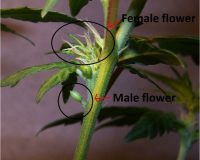It is that time of year where the holidays afford us an opportunity for rest, recuperation and introspection. Becoming a new father to a healthy baby girl and having the privilege to make a living as a scientist, fills me with an immeasurable sense of appreciation and indebtedness. I’ve also been extremely fortunate this year to spend significant time with world-renowned cannabis experts, such as Christian West, Adam Jacques and Elton Prince, whom have shared with me a tremendous wealth of their knowledge about cannabis cultivation and the development of unique cannabis genetics. Neither of these gentlemen have formal scientific training in plant genetics; however, through decades of experimentation, observation and implementation, they’ve very elegantly used alchemy and the principles of Mendelian genetics to push the boundaries of cannabis genetics, ultimately modulating the expression of specific cannabinoids and terpenes. Hearing of their successes (and failures) has triggered significant wonderment and curiosity with respect to what can be done beyond the genetic level to keep pushing the equilibrium in this new frontier of medicine.
Lighting conditions can greatly impact the expression of terpenes (and cannabinoids) in cannabis.Of course genetics are the foundation for the production of premium cannabis. Without the proper genetic code, one cannot expect the cannabis plant to express the target constituents of interest. However, what happens when you have an elite genetic code, the holy grail of cannabis nucleotides if you will, and yet your plant does not produce the therapeutic compounds that you want and/or that are reflective of that elite genetic code? This ‘loss in translation’ can be explained by transcriptomics, and more specifically, epigenetics. In order for the genetic code (DNA) to be expressed as a gene product (RNA), it must be transcribed, a process that is modulated by epigenetic processes like DNA methylation and histone modification. In other words, the methylation of the genetic code can dictate whether or not a particular segment of DNA is transcribed into RNA, and ultimately expressed in the plant. To put this into context, if the DNA code for the enzyme THCA synthase is epigenetically silenced, then no THCA synthase is produced, your cannabis cannot convert CBGA into THCA, and now you have hemp that is devoid of THC.So what is the best lighting technology to enhance the expression of terpenes?
With all of that being said, how do we ensure that our plants thrive under favorable epigenetic conditions? The answer is the environment; and the expression of terpenes is an ideal indicator of favorable environmental conditions. While amazing anti-inflammatories, anti-oxidants and metabolic regulators for humans, terpenes are also extremely powerful anti-microbial agents that act as a robust a line of defense for the plant against bacteria and pests. So, if the threat of microbes can induce the expression of terpenes, then what about other environmental factors? I am of the opinion that the combination of increased exposure to bacteria and natural sunlight enhances the expression of terpenes in outdoor-grown cannabis compared to indoor-grown cannabis. This is strictly my opinion based off of my own qualitative observations, but the point being is that lighting conditions can greatly impact the expression of terpenes (and cannabinoids) in cannabis.

So what is the best lighting technology to enhance the expression of terpenes? Do I use full spectrum lighting or specific frequencies? The answer to these questions is that we don’t fully know at this point. Thanks to the McCree curve we have a fundamental understanding of the various frequencies within the visible light spectrum (400-700nm) that are beneficial to plants, also known as Photosynthetically Active Radiation (PAR). However, little-to-no research has been conducted to determine the impacts that the rest of the electromagnetic spectrum (also categorized as ‘light’) may have on plants. As such, we do not know with 100% certainty what frequencies should be applied, and at what times in the growth cycle, to completely optimize terpene concentrations. This is not to disparage the lighting professionals out there that have significant expertise in this field; however, I’m calling for the execution of peer-reviewed experiments that would transcend the boundaries of company white papers and anecdotal claims. In my opinion, this lack of environmental data provides a real opportunity for the cannabis industry to initiate the required collaborations between cannabis geneticists, technology companies and environmental scientists. This is one field of research that I wish to pursue with tenacity and I also welcome other interested parties to join me in this data quest. Together we can better understand the environmental factors, such as lighting, that are acting as the molecular light switches at the interface of genetics and transcriptomics in cannabis.








